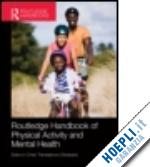Physical Activity as a Mental Health Intervention in the Era of Managed Care: A Rationale - Panteleimon Ekkekakis SECTION 1: The physical activity "feel good" effect - Section Editor: Panteleimon Ekkekakis Chapter 1: Pleasure from the exercising body: Two centuries of changing outlooks in psychological thought - Panteleimon Ekkekakis Chapter 2: Physical activity and reward: The role of endogenous opioids - -Henning Boecker and Rod K. Dishman Chapter 3: Physical activity feel-good effect: The role of endocannabinoids - Francis Chaouloff, Sarah Dubreucq, Isabelle Matias and Giovanni Marsicano Chapter 4: Physical activity and reward: The role of dopamine - Justin S. Rhodes and Petra Majdak SECTION 2: Anxiety disorders - Section Editor: Jasper A.J. Smits Chapter 5: The relationship between physical activity and anxiety and its disorders - Angela Utschig, Michael W. Otto, Mark Powers and Jasper A.J. Smits Chapter 6: Mechanisms underlying the relationship between physical activity and anxiety: Human data - Katharina Gaudlitz, Brigitt-Leila von Lindenberger, Elisabeth Zschucke and Andreas Ströhle Chapter 7: Mechanisms underlying the relationship between physical activity and anxiety: Animal data - Benjamin N Greenwood and Monika Fleshner SECTION 3: Depression and mood disorders - Section Editor: Lynette L. Craft Chapter 8: Exercise and physical activity in the prevention and treatment of depression - Patrick J. Smith and James A. Blumenthal Chapter 9: Potential psychological mechanisms underlying the exercise and depression relationship - Lynette L. Craft Chapter 10: The neurobiology of depression and physical exercise - Michael Chen SECTION 4: Self-perceptions and self-evaluations - Section Editor: Kathleen A. Martin Ginis Chapter 11: Physical activity and self-perceptions among children and adolescents - Lindsay E. Kipp and Maureen R. Weiss Chapter 12: Physical activity and self-perceptions among adults - Peter R. E. Crocker, Carolyn E. McEwen and Amber D. Mosewich Chapter 13: Identities, schemas and definitions: How aspects of the self influence exercise behavior - Shaelyn Strachan and Diane Whaley Chapter 14: Physical activity and personal agency: Self-efficacy as a determinant, consequence, and mediator - Edward McAuley, Emily Mailey, Amanda Szabo and Neha Gothe Chapter 15: Physical activity and body image - Kathleen A. Martin Ginis, Desmond McEwan and Rebecca Bassett-Gunter SECTION 5: Cognitive function across the lifespan - Section Editor: Jennifer L. Etnier Chapter 16: Physical activity: Relations with children's cognitive and academic performance - Jennifer I. Gapin, Lisa A. Barella and Jennifer L. Etnier Chapter 17: Exercise effects on brain and cognition in older adults - Michelle W. Voss and Kirk I. Erickson Chapter 18: Physical activity, cognitive impairment, and dementia - Laura E Middleton, Kristine Yaffe and Deborah Barnes Chapter 19: Exercise and cognitive function: Neurobiological mechanisms - Nicole C. Berchtold and Carl W. Cotman SECTION 6: Psychosocial stress - Section Editor: Mark Hamer Chapter 20: Physical activity, stress reactivity, and stress-mediated pathophysiology - Mark Hamer and Andrew Steptoe Chapter 21: Impact of physical activity on diurnal rhythms: A potential mechanism for exercise-induced stress resistance and resilience - Monika Fleshner, Robert S. Thompson and Benjamin N Greenwood Chapter 22: Physical activity and stress: Peripheral physiological adaptations - Jacqueline Beaudry, Anna D’souza and Michael C. Riddell Chapter 23: Physical activity, stress, and immune function - Kate M. Edwards and Paul J. Mills SECTION 7: Pain - Section Editor: Dane B. Cook Chapter 24: The interaction of musculoskeletal pain and physical activity: Human studies - Thomas Graven-Nielsen, Henrik B Madsen and Lars Arendt-Nielsen Chapter 25: Effects of physical activity on laboratory pain: Studies on animals - Kathleen A. Sluka Chapter 26: Effects of acute and chronic physical activity on chronic pain conditions - Aaron J. Stegner. Morgan R. Shields, Jacob D. Meyer and Dane B. Cook Chapter 27: Physical activity and pain: Neurobiological mechanisms - Laura D. Ellingson and Dane B. Cook SECTION 8: Energy and fatigue - Section Editor: Justy Reed Chapter 28: Effect of acute and regular aerobic physical activity on positive activated affect - Justy Reed Chapter 29: Physical activity and feelings of fatigue, Timothy W. Puetz and Matthew P. Herring Chapter 30: Tired of being sedentary: Physical activity as a treatment goal in patients with chronic fatigue syndrome - Jo Nijs, Mira Meeus, Jessica Van Oosterwijck, Kelly Ickmans, Inge van Eupen and Daphne Kos SECTION 9: Addictions - Section Editor: Michael Ussher Chapter 31: Physical activity as an aid in smoking cessation - Adrian H. Taylor and Michael Ussher Chapter 32: Physical activity and alcohol and drug use disorders - Ana M. Abrantes, Stephen Matsko, Jessica Wolfe and Richard A. Brown Chapter 33: The neurobiology of exercise and drug-seeking behavior - Mark A. Smith and Wendy J. Lynch SECTION 10: Quality of life in special populations - Section Editor: S. Nicole Culos-Reed Chapter 34: Role of physical activity in older adults' quality of life - Steriani Elavsky and Edward McAuley Chapter 35: Physical activity and quality of life in cardiovascular and pulmonary diseases - Charles F. Emery, Risa N. Long and KayLoni L. Olson Chapter 36: Physical activity and quality of life in cancer survivors - Jeffrey Vallance, S. Nicole Culos-Reed, Michael Mackenzie and Kerry S. Courneya Chapter 37: Physical activity and quality of life in multiple sclerosis - Robert W. Motl Chapter 38: Exercise and quality of life in schizophrenia - Guy Faulkner, Paul Gorczynski and Kelly Arbour-Nicitopoulos Postscript - Panteleimon Ekkekakis











